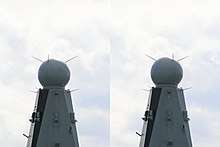Type 45 destroyer
The Type 45 destroyer, also known as the D or Daring class, is a class of six guided missile destroyers built for the United Kingdom's Royal Navy. The class is primarily designed for anti-aircraft and anti-missile warfare and is built around the PAAMS (Sea Viper) air-defence system utilizing the SAMPSON AESA and the S1850M long-range radars. The first three destroyers were assembled by BAE Systems Surface Fleet Solutions from partially prefabricated "blocks" built at different shipyards; the remaining three were built by BAE Systems Maritime – Naval Ships. The first ship in the Daring class, HMS Daring, was launched on 1 February 2006 and commissioned on 23 July 2009.[17]
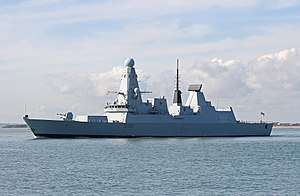 HMS Daring departing Portsmouth Naval Base, 1 March 2010. | |
| Class overview | |
|---|---|
| Name: | Type 45 destroyer |
| Builders: | BAE Systems Maritime – Naval Ships Glasgow Scotland |
| Operators: |
|
| Preceded by: | Type 42 |
| Cost: | Over £1.050B per ship incl. R&D |
| Planned: | 12 (2000), 8 (2004), 6 (ordered)[1][N 1] |
| Completed: | 6 |
| Active: | 6 |
| General characteristics | |
| Type: | Guided missile destroyer |
| Displacement: | 8,700[4] to 9,400 t (9,300 long tons; 10,400 short tons)[6][7] |
| Length: | 152.4 m (500 ft 0 in) |
| Beam: | 21.2 m (69 ft 7 in) |
| Draught: | 7.4 m (24 ft 3 in) |
| Installed power: |
|
| Propulsion: |
|
| Speed: | In excess of 32 kn (59 km/h; 37 mph) |
| Range: | In excess of 7,000 nautical miles (13,000 km) at 18 kn (33 km/h; 21 mph) |
| Complement: | 191[10] (accommodation for up to 285) |
| Sensors and processing systems: |
|
| Electronic warfare & decoys: |
|
| Armament: |
|
| Armour: | Kevlar splinter protection, 30mm magazine/VLS |
| Aircraft carried: |
|
| Aviation facilities: | |
The Type 45 destroyers were built to replace the Type 42 (Sheffield-class) destroyers that had served during the Falklands War, with the last Type 42 being decommissioned in 2013. The National Audit Office reported that, during an "intensive attack", a single Type 45 could simultaneously track, engage and destroy more targets than five Type 42 destroyers operating together.[18] After the launch of Daring on 1 February 2006 Admiral Sir Alan West, a former First Sea Lord, stated that it would be the Royal Navy's most capable destroyer ever, as well as the world's best air-defence ship.[19] The reduction in the number to be procured from twelve, then to (up to) eight, finally with only six confirmed (in 2008) was controversial.[20][21]
In 2016 it was revealed that due to a design flaw on the Northrop Grumman intercooler which, when attached to the Rolls-Royce WR-21 gas turbines and functioning in the warm climate of the Persian Gulf, power availability was diminished considerably;[22][23] and it quickly became apparent that the class was not operating as originally envisioned.[24] A refit will take place from 2019-21 to fully resolve the problems with the six ships in the class.[25]
Development
The UK had sought to procure a new class of air-defence guided missile destroyers in collaboration with seven other NATO nations under the NFR-90 project; the project collapsed due to varying requirements of the different countries involved. The UK then joined France and Italy in the Horizon-class frigate programme; however, differing national requirements, workshare arguments and delays led to the UK withdrawing on 26 April 1999 and starting its own national project.[26] On 23 November 1999 Marconi Electronic Systems (MES) was confirmed as prime contractor for the Type 45 project.[27] Seven days later MES and British Aerospace merged to form BAE Systems (BAE), making the latter the prime contractor.
The Type 45 project has been criticised for rising costs and delays, with the six ships costing £6.46 billion, an increase of £1.5 billion (29%) on the original budget.[1] The first ship entered service in 2010,[28] rather than 2007 as initially planned. In 2007, the Defence Select Committee expressed its disappointment that the Ministry of Defence (MOD) and BAE had failed to control rising costs.[29][30]
Construction
The Type 45 destroyers take advantage of some Horizon development work and use the Sea Viper air-defence system and the SAMPSON radar. The ships are built by BAE Systems Maritime – Naval Ships, originally created as BVT Surface Fleet by the merger of the surface shipbuilding arms of BAE Systems and VT Group. These two companies previously built the ships in collaboration. BAE's two Glasgow shipyards and single Portsmouth shipyard are responsible for different "blocks". BAE's Govan yard is responsible for Block A (stern to edge of helicopter hangar). The Scotstoun yard builds Blocks B/C (a 2600 tonne section which contains the Rolls-Royce WR-21 gas turbines, starts with the helicopter hangar to the bridge section) and Block D (bridge section itself). BAE's Portsmouth shipyard is responsible for Blocks E/F (bridge to the bow) and the funnels and masts. For ships 2 to 6 blocks A-D were assembled in the Ships Block and Outfit Hall of the Govan shipyard, and taken fully outfitted to the Scotstoun berth. The masts and funnels were also fitted before launch.
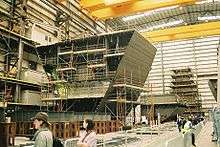
For the first-of-class, Block A was assembled at Govan and moved to Scotstoun, where it was mated to Block B/C, which was already fitted with the WR-21 turbines and machinery. Block D, also assembled at Scotstoun, was fitted to these three blocks. The bow sections (E/F) were mated at Portsmouth and taken by barge to Scotstoun. These were the final blocks to be attached. At this point the hull was launched into the Clyde and towed to the Scotstoun Dry Dock where the masts and funnels were fitted (the masts are partially outfitted with equipment, for example the mast for the S1850M radar is sent from Portsmouth to Thales Nederland to be fitted with radar equipment). Once this is complete, the remaining equipment is fitted: radar arrays, bow-mounted sonar, propellers, missile equipment and 4.5-inch gun.
This modular construction arrangement was agreed in February 2002. However, when the original contract for three ships was signed in July 2000, BAE Systems Marine was to build the first and third ships, and Vosper Thornycroft (now VT) was to build the second.
By the end of 2010, all six Type 45 destroyers had been launched, with the first two in commission and the remainder fitting out. By 2012, all destroyers were structurally complete and the production lines had been closed. Duncan, the last of the Type 45 destroyers, was commissioned at Portsmouth Naval Base on 26 September 2013, and entered service in 2014 after trials and training.[31]
The Daring class are the largest escorts ever built for the Royal Navy in terms of displacement.[N 3]
In 2009 delivery of the ships' Aster missiles was delayed due to a manufacturing fault with a single batch of missiles identified during testing.[32] [33]
Characteristics
General specifications
The Type 45 destroyers are 152.4 m (500 ft 0 in) in length, with a beam of 21.2 m (69 ft 7 in), a draught of 7.4 m (24 ft 3 in) and a displacement of approximately 8,500 tonnes (8,400 long tons).[4] This makes them significantly larger than the Type 42 they replace (displacement 5,200 tonnes, 5,100 long tons, 5,700 short tons). The Type 45 destroyers are the first British warships built to meet the Lloyd's Register's Naval Ship Rules for hull structure requiring design approval by Lloyd's Register for the principal structural arrangements of the vessel.[34] BAE Systems is the Design Authority for the Type 45, a role traditionally held by the UK Ministry of Defence.[35] The design of the Type 45 brings new levels of radar signature reduction to the Royal Navy. Deck equipment and life rafts are concealed behind the ship's superstructure panels, producing a very "clean" superstructure, somewhat similar to that of the French La Fayette-class frigates. The mast is also sparingly equipped externally. Speculation by the press suggests that this design gives the ship the radar cross-section of a small fishing boat.[36]
The Daring class is notable for being the first Royal Navy vessels to include gender-neutral living spaces to accommodate male and female crew members; communal shower and heads facilities have given way to individual cubicles, and six-person berths for junior ratings are far more flexible in accommodating a mixture of male and female sailors.[37] Men and women will continue to sleep in separate spaces, in common with most other navies.
Propulsion and power
The Type 45 is fitted with an advanced and innovative integrated electric propulsion system. Historically, electric-drive ships (like USS Langley) have supplied power to their electric motors using DC, and ship's electrical load, where necessary at all, was either separately supplied or was supplied as DC with a large range of acceptable voltage. Integrated electric propulsion seeks to supply all propulsion and ship's electrical load using alternating current at a high quality of voltage and frequency.[N 4] This is achieved by computerised control, high quality transformation, and electrical filtering. Two Rolls-Royce WR-21 gas turbines drive GE alternators and along with two Wärtsilä 12V200 diesel generators provide electrical power at 4,160 volts to a GE high voltage system. The high voltage supply is then used to provide power to two GE Power Conversion advanced induction motors with outputs of 20 MW (27,000 hp) each. Ship's services, including hotel load and weapons system power supplies, are supplied via transformers from the high voltage supply at 440 V and 115 V.[38] The benefits of integrated electric propulsion are cited as:
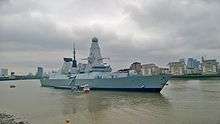
- The ability to place the electric motors closer to the propeller, thus shortening the shaftline, obviating the need for a gearbox or controllable pitch propellers, and reducing exposure to action damage.[38]
- The opportunity to place prime movers (diesel generators and gas turbine alternators) at convenient locations away from the shaftline, thus reducing the space lost to funnels, while at the same time improving access for maintenance and engine changes.[39]
- The freedom to run all propulsion and ship services from any combination of prime movers, including from a single prime mover for much of the ship's life, thus dramatically reducing engine running hours and emissions.[38]
- The ability to share transiently and permanently prime mover power between services and propulsion allows significant potential to accommodate future increases in service and weapon loads with minimal impact on ship speed or prime movers.
The key to the efficient use of a single prime mover is the choice of a gas turbine that provides efficiency over a large load range; the WR-21 gas turbine incorporates compressor intercooling and exhaust heat recovery, making it significantly more efficient than previous marine gas turbines, especially at low and medium load. The combination of greater efficiency and high fuel capacity gives an endurance of 7,000 nautical miles (13,000 km) at 18 knots (33 km/h).[38] High power density and the hydrodynamic efficiency of a longer hull form allow high speeds to be sustained. It has been reported that Daring reached her design speed of 29 knots (54 km/h) in 70 seconds and achieved a speed of 31.5 knots (58 km/h) in 120 seconds during sea trials in August 2007.[40]
Engine trouble
In January 2016, the Ministry of Defence acknowledged that the Northrop Grumman intercooler in the propulsion system was unreliable.[23][41][42] A staggered refit was also announced, which will involve cutting into the ship's hulls and fitting additional diesel generation capacity.[43][44] On occasion there have been near-complete power generation failures, temporarily disabling propulsion, power generation for weapons, navigational systems and other purposes, leaving the ships vulnerable to "total electric failure".[45][46]
In June 2016, defence chiefs stated that the Northrop Grumman intercooler could not cope with the warm waters of the Gulf. The manufacturers, Rolls-Royce, said that while the engines for the WR-21 had been built as specified by the Ministry of Defence, the conditions in the Middle East were not "in line with the specs of the intercooler".[47][48] The First Sea Lord, Admiral Philip Jones, clarified that the "WR-21 gas turbines were designed in extreme hot weather conditions to what we call "gracefully degrade" in their performance, until you get to the point where it goes beyond the temperature at which they would operate... we found that the resilience of the diesel generators and the WR-21 in the ship at the moment was not degrading gracefully; it was degrading catastrophically, so that is what we have had to address".[24]
While the Ministry of Defence does not release detailed information related to the number of problems experienced by the class, including total engine failure, several such occasions have been reported in the media. Daring broke down in November 2010 and April 2012, Dauntless in February 2014 and Duncan in November 2016.[49][50][51][52][53]
On 23 November 2017, The Register, a British technology news and opinion website, quoting The Times, reported that a Type 45 destroyer had been recalled to Britain with propeller problems, leaving the Royal Navy's traditional "east of Suez" deployment without proper warship cover. It was stated that "HMS Diamond is on her way back to the UK after a propeller problem proved too much for the ship's crew to repair on their own. The problem is not linked to the Type 45's notoriously unreliable WR-21 engines. Rumours have swirled that Diamond is a testbed for an interim fix before a proper solution is rolled out in 2019... the withdrawal of Diamond from her planned nine-month deployment leaves naval planners in a very difficult situation. While the RN does have a permanent presence in the Middle East, at the moment it is down to four minesweepers and their lightly armed support ship."[54]
On 21 March 2018, it was announced that each ship would have their two diesel engines replaced by three new ones at Cammell Laird in Birkenhead as part of the "Power Improvement Project" (PIP).[55]
Advanced air-defence
The Type 45 destroyers are primarily designed for anti-air warfare with the capability to defend against targets such as fighter aircraft and drones as well as highly maneuverable sea skimming anti-ship missiles travelling at supersonic speeds.[56] The Royal Navy describes the destroyers' mission as being "to shield the Fleet from air attack".[4]
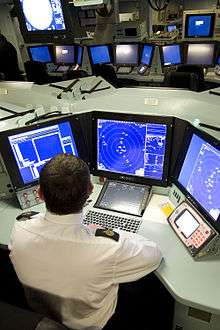
The Type 45 destroyer is equipped with the Sea Viper (PAAMS) air-defence system utilizing the SAMPSON active electronically scanned array multi-function radar and the S1850M long-range radar. PAAMS is able to track over 2,000 targets and simultaneously control and coordinate multiple missiles in the air at once, allowing a large number of tracks to be intercepted and destroyed at any given time. This makes it particularly difficult to swamp PAAMS during a saturation attack, even if the attacking elements are supersonic.[57] The US Naval War College has suggested that the SAMPSON radar is capable of tracking 1,000 objects the size of a cricket ball travelling at three times the speed of sound (Mach 3), emphasising the system's capabilities against high performance stealth targets.[56]
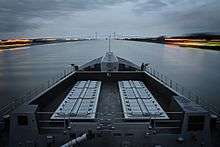
A core component of PAAMS is the Aster missile, comprising Aster 15 and Aster 30. MBDA describe Aster as a "hit-to-kill" anti-missile missile capable of intercepting all types of high performance air threats at a maximum range of 120 km.[58] The Aster missile is autonomously guided and equipped with an active RF seeker enabling it to cope with "saturated attacks" thanks to a "multiple engagement capability" and a "high rate of fire".[58] Presently the Daring-class destroyers are equipped with a 48-cell A50 Sylver Vertical Launching System allowing for a mix of up to 48 Aster 15 and 30 missiles.
In addition to its anti-air warfare role, PAAMS offers additional ballistic missile defence capabilities. In March 2013 the United States Naval Institute reported that the Royal Navy along with the United States Missile Defense Agency will explore the potential of the Daring class to provide ballistic missile defence in Europe along with United States Navy Aegis equipped destroyers.[59] In May 2014, it was reported by Jane's Information Group that the United Kingdom is committing more funds to explore the capabilities of the SAMPSON multi-function radar and the Type 45 destroyer in a ballistic missile defence role. This followed a successful live firing event hundreds of miles north of Kwajalein Atoll in the Western Pacific Ocean, where Daring demonstrated the ability to "detect at the earliest opportunity" and track "through to intercept" two medium-range ballistic missiles. BAE systems reportedly told Jane's that the SAMPSON multi-function radar "exceeded expectations in all respects". An "Experiment Concurrency and Cueing (TECC)" event for the Type 45 was planned for late 2015.[60]
Because of the marked increase in capabilities delivered by the Type 45 destroyers in relation to their predecessors, the exceptionally high price per ship, and the large amount of public attention they have attracted, defence analysts and correspondents commonly refer to the Daring class as being the "most advanced" or "most powerful" air-defence destroyers in the world.[61] Likewise, the ships' builders BAE Systems claim: "Able to detect and track hundreds of targets simultaneously, the Type 45 Destroyer is recognised as the most advanced anti-air warfare vessel in the world."[62] Nick Brown, the editor-in-chief of Jane's International Defence Review, was quoted by The Huffington Post (a US online news aggregator and blog) saying, "It's [Type 45 destroyer] certainly one of the most advanced air defence ships in the world... The US Aegis system is similar, but Sea Viper is more advanced."[63]
Weapons, countermeasures, capabilities and sensors
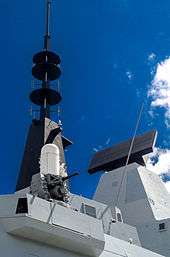
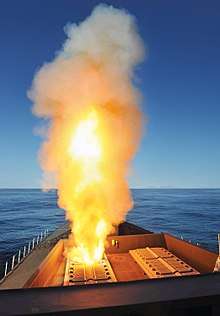
Anti-air warfare
The Sea Viper air-defence system:
- SAMPSON active electronically scanned array multi-function air tracking radar, capable of tracking hundreds of targets (range 400 km, 250 mi).
- S1850M 3D long-range air surveillance radar, capable of tracking up to 1,000 targets (range 400 km).
A 48-cell A50 Sylver Vertical Launching System for a mix of up to 48:
- Aster 15 missiles, range 1.7–30 km (1.1–18.6 mi).
- Aster 30 Block 0 missiles, range 3–120 km (1.9–74.6 mi).
The Type 45 does not have a formal theatre ballistic missile defence (TBMD) capability but its potential for such a role is being assessed.[64] Land-based Aster 30 Block 1 missiles have intercepted short-range ballistic missiles[65] and trials of a land-based SAMPSON modified for BMD were planned for early 2012.[66] The Ministry of Defence announced in 2013 that the first ship, Daring, would take part in ballistic defence trials with the US Missile Defence Agency (MDA) as part of a major research and development programme.[67] In March 2016 Britain and France announced a joint procurement programme with the intention of France acquiring Brimstone missiles to equip the Tiger Mk3 helicopter and Britain acquiring Aster Block 1NT missiles capable of intercepting medium range ballistic missiles of 1,000–1,500 km (620–930 mi) range. A block 2 version of the Aster 30 NT is under development by France and Italy capable of intercepting 3,000 km (1,900 mi) range missiles.[68] MBDA are the prime contractor for both the weapons systems (Sea Viper) and the Samson radar with BAE systems as the secondary contractor reporting to MBDA.
Guns
- 1 × BAE Systems 4.5 inch Mark 8 Mod 1 naval gun. As of November 2011 the Mk8 Mod 1 is scheduled to remain in service until the 2030s, with a Mod 2 upgrade along the way to address obsolescence.[69] The limitations of the 4.5-inch gun mean it is likely that the Type 45 will receive a new gun before then, the same Medium-Calibre Gun System (MCGS) that is being procured to meet the Maritime Indirect Fire System (MIFS) requirement of the new Type 26 frigate (Global Combat Ship).[69] In 2015, the BAE Mk45 Mod 4 5"/62 was selected for the Type 26 frigate.[70]
- 2 × 30 mm Small Calibre Gun on single DS-30B mounts.
- 2 × Phalanx 20 mm calibre close-in weapons systems (CIWS).[71]
- 2 × 7.62 mm miniguns.[72]
- Up to 6 × L7A2 General Purpose Machine Guns.[72]
Aviation
The flight deck of the Type 45 is large enough to accommodate aircraft up to the size of a Chinook helicopter.[73] It has hangar space for either one Merlin HM1 or two Lynx helicopters.[73] Both types have a dipping sonar, sonobuoys and radar; the Merlin carries four anti-submarine Sting Ray torpedoes whilst the smaller Lynx HMA8 carried either two Sting Ray or four Sea Skua anti-ship missiles. From 2015 the Lynx has been replaced in RN service by the AW159 Wildcat whose weapons will include the Lightweight Multirole Missile and FASGW(H) missile.[74]
Anti-ship, submarine and land-attack
- Four of the six Type 45 destroyers will receive Harpoon launchers recycled from the last four decommissioned Type 22 frigates.[75] On 2 March 2015, Duncan set sail on her maiden deployment equipped with Harpoon anti-ship missiles.[76] On 23 March 2015, the crew of Diamond rejoined their ship following a refit which included the installation of Harpoon.[77] In 2014 HMS Daring underwent maintenance to receive Harpoon missiles.[78]
- The Type 45 has a bow-mounted medium-frequency Ultra/EDO MFS-7000 sonar but its main anti-submarine weapon is its helicopter(s). As of August 2013 there were no plans to fit anti-submarine torpedo tubes.[75]
- The 4.5-inch Mark 8 Mod 1 naval gun can be used against ships and naval gunfire support (NGS) against land targets.
Countermeasures
- The Seagnat decoy system allows for the seduction and distraction of radar guided weapons, through active and passive means. An infrared countermeasure device is planned for future retrofits.
- Airborne Systems's Naval Decoy IDS300[79] floating naval decoy system (corner reflectors).[80]
- Surface Ship Torpedo Defence System (SSTD) active torpedo decoy system.
Communications and other systems
- Fully Integrated Communications System (FICS45): a combined external and internal communications system supplied by Thales and Selex ES Ltd.[81]
- In 2012, the UAT Mod2.0 digital Radar Electronic Surveillance system was fitted to Daring and Diamond as part of a £40m contract with Thales UK that will see UAT Mod2.1 fitted to the other Type 45's.[13]
- METOC Meteorology and Oceanography: The Metoc system by BAE Systems comprises the Upper Air Sounding System using launchable radiosondes by Eurodefence Systems Ltd and Graw Radiosondes (Germany) joint venture, as well as a comprehensive weather satellite receiving system and a bathymetrics system. These sensors provide each vessel with full environmental awareness for tasks such as radar propagation, ballistics and general self-supporting meteorological and oceanographic data production.
Additional capabilities
- Type 45 has sufficient space to embark 60 Royal Marines and their equipment.[4]
- The Type 45 destroyers are designed with the configuration and capacity to be operate as flagships.[82]
Ships in the class

.jpg)
Six ships have been ordered, and transfer of custody of the first happened on 10 December 2008.[83] The MoD's initial planning assumption was to procure twelve ships (essentially a like-for-like replacement of a similar number of Type 42s), with the size of the second batch to be determined between 2005 and 2010.[2] However this was reduced to eight ships in the 2003 defence white paper entitled Delivering Security in a Changing World: Future Capabilities, following a strategic refocusing on "small to medium-scale operations" and expeditionary land operations.[56] It was reported in December 2006 that the last two could be cut.[84] In July 2007, Ministry of Defence officials stated that they "still planned to build eight Type 45 destroyers" and that "the extra two ships were still included in planning assumptions".[85] This plan was officially abandoned on 19 June 2008 when the Minister for the Armed Forces, Bob Ainsworth, announced in Parliament that options for the seventh and eighth destroyers would not be taken up.[3][86] The continual scaling back of the project, first from twelve to eight, and subsequently to six ships, has been criticised for leaving the Royal Navy with insufficient ships to meet its requirements.[20][21]
On 9 March 2007, The Independent reported that Saudi Arabia was considering buying "two or three" Type 45s.[87] On 7 September 2007 it was reported that Saudi Arabian officials had been invited to observe Daring's sea trials.[88]
In 2009 the House of Commons Public Accounts Committee conducted an enquiry into the procurement. Its main conclusions were that despite the destroyer being based on 80% new technology, there was a failure to take sufficient account of technical risk, over-optimism, and an inappropriate too-early fixed price project entered into before many elements had been specified. This resulted in a difficult commercial relationship until a contract renegotiation in 2007. It noted that the MoD believed six ships would still enable it to meet the operational requirement of having five ships at sea, with only a small risk of failing to meet that requirement.[1]
In July 2016, it was reported that all six of the class were docked in Portsmouth. The Ministry of Defence said it was "unusual but not unprecedented" and that "All Type 45 destroyers are currently in port as they have either just returned from operations, or are about to be deployed, are conducting training or carrying out maintenance or are home for crew to take summer leave."[89]
In an interview with the Sunday Times, former Rear Admiral Chris Parry claimed that the Type 45 destroyers are noisy ships which can be heard 100 miles (160 km) away by submarines.[90]
The entire class is based at HMNB Portsmouth.[91]
| Name | Pennant No. | Builder | First steel cut[N 6] | Launched | Date of commission | Status |
|---|---|---|---|---|---|---|
| Daring | D32 | BAE Systems Surface Ships | 28 March 2003 | 1 February 2006 | 23 July 2009[92] | As of June 2020, laid up since 2017 and now under refit. |
| Dauntless | D33 | BAE Systems Surface Ships | 26 August 2004 | 23 January 2007 | 3 June 2010[94] | Since Feb 2016, she had been relegated to a Harbour Training Ship at HMNB Portsmouth. As of May 2020, undergoing refit in Birkenhead at Cammell Laird for the first PIP, due to return to service 2021[95] |
| Diamond | D34 | BAE Systems Surface Ships | 25 February 2005 | 27 November 2007 | 6 May 2011[96] | In active service |
| Dragon | D35 | BAE Systems Surface Ships | 19 December 2005 | 17 November 2008 | 20 April 2012[97] | In active service |
| Defender | D36 | BAE Systems Surface Ships | 31 July 2006 | 21 October 2009 | 21 March 2013[98] | In active service |
| Duncan | D37 | BAE Systems Surface Ships | 26 January 2007 | 11 October 2010 | 26 September 2013[99] | As of May 2020, undergoing refit [100] |
Only three ships of the Type 45 Daring class carry the same names as members of the previous Daring-class destroyers of 1949; these are: Daring, Diamond and Defender. These names had been used for the D-class destroyers of the 1930s, with the addition of Duncan, which was also one of the Type 14 frigates in the 1950s. The remaining Type 45 names, Dauntless and Dragon, were previously carried by D-class cruisers of 1918, which served until 1945.
See also
- Arleigh Burke-class destroyer
- De Zeven Provinciën class frigate
- Atago-class destroyer
- Sejong the Great-class destroyer
- Type 052D destroyer
Footnotes
- Six hulls were originally ordered, with a planning assumption that a further six would be ordered between 2005 and 2010.[2] This planning assumption was later reduced to a further two. In the 2008 defence budget, the Global Combat Ship programme (known then as the FSC) was brought forward at the expense of ships 7 and 8, resulting in the final order being left at six, with options for further ships not being taken up.[3]
- The Harpoon missile is to be fitted to four of the six ships. HMS Duncan is to be the first.[15]
- Largest in terms of displacement; however, the 6,200-ton County-class destroyers were some 6 metres (20 ft) longer, and the 6,300-ton Type 82 destroyer was 2 metres (6.6 ft) longer.
- High quality indicates that the frequency and voltage are stable, with an absence of spikes, even under changes in power demand.
- Early in the design phase it was estimated that 16 strike-length tubes could be fitted and this number has been widely circulated, but as of 2010 the RN website said 12.
- The Type 45 is constructed in modules, so the keel is not "laid down" as in the past. The ceremonial start of the ships' construction is "cutting the first sheet" of steel.
References
- Ministry of Defence: Type 45 Destroyer (PDF). House of Commons Public Accounts Committee (Report). UK Parliament. 1 June 2009. pp. 5–13. HC 372. Retrieved 15 June 2020.
- "Appendix – Warship Building Strategies". Major Procurement Projects: Government Response. House of Commons Defence Committee. 24 October 2002. ISBN 978-0-21-500586-1. HC 1229. Archived from the original on 29 August 2012. Retrieved 29 May 2010.
The MoD intends to make a decision on the size of the next batch of Type-45s in the second half of the decade. Until the main investment decision on the next batch is made, the size of that batch will remain a planning assumption.
- Ministry of Defence Annual Report and Accounts Volume I including the Annual Performance Report and Consolidated Departmental Resource Accounts (PDF). Ministry of Defence (Report). HM Government. 21 July 2008. p. 98. ISBN 978-0-10-295509-5. HC 850-I. Archived from the original (PDF) on 7 June 2011. Retrieved 26 July 2011.
Six of these highly advanced and capable ships have been ordered, but following the 2008 planning round we no longer intend to place orders for any further Type 45 destroyers.
- "Type 45 Destroyer". Royal Navy. Retrieved 6 November 2011.
- "For Queen and Country". Navy News. Royal Navy. July 2012. p. 8.
One hundred or so miles west of the largest city of Abidjan lies the fishing port of Sassandra, too small to accommodate 8,500-tonnes of Type 45.
- "HMS Duncan joins US Carrier on strike operations against ISIL". Navy News. Royal Navy. 7 July 2015. Retrieved 9 July 2015.
As well as supporting the international effort against the ISIL fundamentalists – the 8,500-tonne warship has also joined the wider security mission in the region.
- "HMS Daring". Wärtsilä. Archived from the original on 28 October 2014. Retrieved 1 August 2011.
- Aquilina, Pauline J.; Michell, Simon, eds. (24 April 2013). "Royal Navy Fleet Guide". A Global Force 2012/13 (PDF). Newsdesk Media. p. 2. ISBN 978-1-906940-75-1. Archived from the original (PDF) on 3 December 2014.
- "Raytheon Systems Ltd awarded further contract for Integrated Navigation System shipsets for the Type 45" (PDF). Raytheon. 8 March 2006. Archived from the original (PDF) on 13 March 2012. Retrieved 31 January 2008.
- "Ultra Electronics Series 2500 electro-optic tracking and fire-control system (United Kingdom)". Jane's Electro-Optic Systems. 28 October 2010. Archived from the original on 3 May 2012. Retrieved 21 August 2011.
- "Fleet to get the latest in electronic surveillance" (PDF). DESider. Ministry of Defence. September 2012. p. 18. Archived from the original (PDF) on 5 September 2012.
- Scott, Richard (29 June 2014). "UK to buy Shaman CESM for Seaseeker SIGINT programme". IHS Jane's 360. Archived from the original on 7 July 2014.
- "HMS Duncan (D37)". Royal Navy.
- "Air Defence Destroyer (T45)". Royal Navy. Archived from the original on 31 October 2007. Retrieved 20 November 2007.
- "UK Royal Navy Commissions Type 45 Destroyer HMS Daring". Defence Professionals. 24 July 2009. Archived from the original on 26 July 2009. Retrieved 25 July 2009.
- "Providing Anti Air Warfare Capability: the Type 45 destroyer" (PDF). National Audit Office. 13 March 2009. p. 12. Retrieved 8 March 2014.
In an intensive attack, a Type 45 destroyer would be able to simultaneously track, engage and destroy more targets than the remaining Type 42 destroyers operating together.
- Nicoll, Alexander (1 February 2006). "Countess of Wessex Launches Royal Navy's New Warship". Government News Network. Archived from the original on 27 September 2007. Retrieved 17 August 2007.
- "Six of the best but scrap the rest". Shipping Times. 20 June 2008. Retrieved 16 November 2009.
- See statement by the then First Sea Lord, Admiral Sir Alan West, Jane's Defence Weekly 25 June 2008, p.6 reproduced from an interview in February 2006.
- Chuter, Andrew (23 March 2016). "Fix to UK Destroyer Power Plant Problem Some Way Off". Defence News. Retrieved 17 October 2016.
- "Putting the Type 45 propulsion problems in perspective". Save The Royal Navy. 3 February 2016. Retrieved 17 October 2016.
- "Oral evidence: Naval Procurement: Type 26 and Type 45 HC 221". UK House of Commons Defence Select Committee. 21 July 2016. Retrieved 21 July 2016.
- "Final cure for Type 45 destroyer propulsion problems announced". Save The Royal Navy. 21 March 2018. Retrieved 8 April 2019.
- Nicoll, Alexander (27 April 1999). "National differences scupper frigate project". Financial Times.
- Sinclair, Keith (24 November 1999). "Jobs boost for shipyard; Yarrow confirmed as main contractor for MoD's Type 45 destroyer programme". The Herald. Scottish Media Newspapers. p. 13.
- "Air Defence Destroyer (Type 45)". Royal Navy. Archived from the original on 13 August 2008. Retrieved 14 October 2008.
- Robertson, David (29 January 2008). "Taxpayers face £500m bill for BAE projects". The Times. London, UK. Archived from the original on 12 October 2008. Retrieved 31 January 2008.
- Wilson, Graeme (9 December 2007). "MPs accuse MoD of £2.6bn overspend". The Daily Telegraph. London, UK. Retrieved 31 January 2008.
- "Type 45 destroyer HMS Duncan 'christened' at Portsmouth Naval Base". BBC News. 26 September 2013.
- "Royal Navy destroyers at sea with faulty weapons systems". The News. Portsmouth. 7 December 2009. Archived from the original on 25 March 2010. Retrieved 6 November 2011.
- "MBDA completes four successful ASTER missile firings in less than a month". MBDA Systems. 28 June 2010. Retrieved 9 June 2016.
- Beedall, Richard (18 May 2011). "Type 45 ("D" Class) Destroyer Daring Class: Part 2". Navy Matters. Archived from the original on 5 December 2013. Retrieved 3 January 2014.
- P. J. Gates, Royal Institution of Naval Architects, 2005, p.35.
- Harding, Thomas (15 August 2007). "HMS Daring eases through first sea trials". The Daily Telegraph. Retrieved 9 April 2019.
- "The Comfort of the Crew". BAE Systems. Archived from the original on 13 October 2007. Retrieved 20 November 2007.
- "Type 45 – The Anti-Air Warfare Destroyer" (PDF). Royal Navy. Archived from the original (PDF) on 18 April 2009. Retrieved 8 June 2010.
- Chitale, Captain S. S. (2010). "Integrated Full Electric Propulsion" (PDF). IE(I) Journal. Institution of Engineers (India). 90: 18–22.
- MacDermid, Alan (15 August 2007). "Daring is mean, green and built for speed". The Herald. Archived from the original on 3 February 2009. Retrieved 15 August 2007.
- "Northrop Grumman/Rolls-Royce Team Selected as Preferred Supplier". Defence Aerospace. 1 November 2000. Retrieved 28 April 2016.
- "Engine, Turbine, and Power Transmission Equipment Manufacturing, Marine Engines & Turbines". Janes Navy International. August 2000. Retrieved 28 April 2016.
- Fallon, Michael (3 March 2016). "Problems with Power & Propulsion System of the Type 45 Destroyers" (PDF). Letter to House of Commons Defence Committee. Retrieved 9 April 2019.
- "Project Napier see twin-track plan adopted to resolve Type 45 problems". Warship Technology. Royal Institution of Naval Architects. May 2016.
- Farmer, Ben; Ward, Victoria (29 January 2016). "Royal Navy's 1bn new warships need major engine refit after power failures". The Daily Telegraph. Retrieved 30 January 2016.
- Elgot, Jessica (29 January 2016). "British warships need multimillion-pound refit to stop power failures". The Guardian. Retrieved 30 January 2016.
- Norton-Taylor, Richard (7 June 2016). "Destroyers will break down if sent to Middle East, admits Royal Navy". The Guardian. Retrieved 7 June 2016.
- Britton, Bianca (10 June 2016). "Royal Navy warships breaking down in heat". CNN. Retrieved 22 July 2016.
- Inglis, Will (10 February 2016). "5,000 Faults Recorded On Type 45 Destroyers". Forces TV. Archived from the original on 2 March 2017. Retrieved 6 December 2016.
- Page, Lewis (24 November 2010). "Unarmed Royal Navy T45 destroyer breaks down mid-Atlantic". The Register. Retrieved 6 December 2016.
- Powell, Michael (18 April 2012). "Secret repairs for HMS Daring after she suffers breakdown". The News. Retrieved 6 December 2016.
- Farmer, Ben (24 February 2014). "£1bn HMS Dauntless abandons training exercise after technical trouble". The Daily Telegraph. Retrieved 6 December 2016.
- "Royal Navy Type 45 destroyer towed back to port two days after it sails". The Daily Telegraph. 24 November 2016. Retrieved 6 December 2016.
- Corfield, Gareth (23 November 2017). "Royal Navy destroyer leaves Middle East due to propeller problems". The Register. Retrieved 25 November 2017.
- "BAE Systems, Cammell Laird and BMT team-up to deliver additional Type 45 power generation". BAE Systems. 21 March 2018. Retrieved 21 March 2018.
- Lombardi, Ben; Rudd, David (Summer 2013). "The Type 45 Daring-Class Destroyer: How Project Management Problems Led to Fewer Ships". Naval War College Review. U.S. Naval War College. 66 (3). Archived from the original on 10 October 2013. Retrieved 20 May 2014.
- Beedall, Richard. "UK PAAMS". Navy Matters. Archived from the original on 28 October 2014. Retrieved 31 December 2012.
- "Aster Anti-Missile Missile" (PDF). MBDA. Archived from the original (PDF) on 11 May 2012. Retrieved 20 May 2014.
- LaGrone, Sam (7 March 2013). "U.K. Royal Navy Wants to Bullseye Rogue Missiles with U.S. Help". U.S. Naval Institute. Retrieved 7 March 2013.
- "UK extends Sampson radar experimental BMD research". IHS Jane's 360. 17 May 2014. Retrieved 19 May 2014.
- Harding, Thomas (10 December 2008). "World's most advanced destroyer handed to Royal Navy". The Daily Telegraph. Retrieved 10 December 2008.
- "Products – Destroyers". BAE Systems. Retrieved 21 July 2017.
- Vale, Paul (3 February 2012). "Falkland Islands: HMS Dauntless, The Royal Navy's 'Cutting Edge' Deterrent". The Huffington Post. Retrieved 3 February 2012.
- "Royal Navy destroyer to join ballistic defence trial". Ministry of Defence. 6 March 2013.
- "MBDA's Aster, the first European missile to successfully carry out a ballistic intercept". MBDA Missile Systems. 25 November 2010. Archived from the original on 30 March 2014. Retrieved 18 April 2013.
- Scott, Richard (December 2011). "UK set to test experimental Sampson modified for BMD". Jane's International Defence Review. 44. p. 8.
- Ministry of Defence and Defence Science and Technology Laboratory (6 March 2013). "Royal Navy destroyer to join ballistic defence trial". UK Government. Retrieved 9 June 2016.
- "MBDA: France, UK Agree on 'Cross-Procurement' Policy". Defense News. Retrieved 22 July 2016.
- Scott, Richard (30 November 2011). "Taking aim at Type 26". Jane's Defence Weekly. p. 24. Archived from the original on 14 May 1998.
- "BAE Systems to Provide Mk 45 Mod 4 Naval Gun System for Royal Navy Type 26 Frigates". Navy Recognition.com. Retrieved 22 July 2016.
- "The Best of the UK". Navy News. January 2011. p. 9. Retrieved 26 January 2011.
Daring is currently undergoing a mini overhaul which among other upgrades will see her fitted with Phalanx automated guns
- "HMS Daring: The Warfare Department". Royal Navy. Archived from the original on 20 April 2009. Retrieved 12 August 2013.
- "Dauntless makes history training future front-line Naval aviators". Royal Navy. 12 February 2013.
- Tran, Pierre (6 May 2013). "France OKs Joint Missile Development with UK". Defense News.
- DE&S Policy Secretariat (7 August 2013). "Request for Information under the Freedom of Information Act 2000". WhatDoTheyKnow.
- "HMS Duncan sails for maiden deployment". Royal Navy. 2 March 2015. Retrieved 2 March 2015.
- "HMS Diamond crew back on board after refit". Royal Navy. 23 March 2015. Retrieved 23 March 2015.
- "Daring's Lynx fliers singled out for Philippines disaster mission". Royal Navy. 12 June 2015.
- "Naval Decoy IDS300, Ship Deployed Floating Naval Countermeasure". Airborne Systems. Archived from the original on 11 August 2011. Retrieved 16 July 2011.
- "Type 45 FICS Fully Integrated Communications System" (PDF). Selex Communications.
- Peter Luff, Minister for Defence Procurement (17 March 2011). "Written Answers – Frigates". Parliamentary Debates (Hansard). House of Commons. col. 511W.
- "HMS Daring". Royal Navy. 19 July 2008. Archived from the original on 9 June 2009.
- Harrison, Michael (31 December 2006). "Half of Royal Navy's ships in mothballs as defence cuts bite". The Times. London. Archived from the original on 16 February 2007. Retrieved 19 April 2007.
- Evans, Michael (26 July 2007). "Go-ahead for £4bn aircraft carriers". The Times. London. Retrieved 26 July 2007.
- Kula, Adam (19 June 2008). "Government admits destroyers will never be built". The News. Archived from the original on 27 June 2008. Retrieved 19 June 2008.
- Harrison, Michael (9 March 2007). "UK seeks £2bn Saudi destroyer contract". The Independent. London. Archived from the original on 12 March 2007. Retrieved 9 March 2007.
- Robertson, David (7 September 2007). "BAE poised to clinch £20bn Saudi Eurofighter deal". The Times. London. Retrieved 8 September 2007.
- "Defence in the media". UK Ministry of Defence. 31 July 2016. Retrieved 1 August 2016.
- Hughes, Laura (5 February 2017). "British warships 'so noisy' Russian submarines can hear them 100 miles away, investigation finds". The Daily Telegraph. Retrieved 6 February 2017.
- "Royal Navy's final Type 45 destroyer enters service early". Royal Navy. 31 January 2013. Retrieved 4 January 2014.
- "First port of call for destroyer". BBC News. 22 May 2009. Retrieved 31 May 2009.
- "HMS Dauntless set for Tyne visit". Shields Gazette. 28 April 2010. Archived from the original on 6 September 2010. Retrieved 9 April 2019.
- "HMS Diamond to join fleet". The News. 4 May 2011. Retrieved 6 May 2011.
- "HMS Dragon commissioned". Royal Navy. 20 April 2012. Archived from the original on 22 April 2012. Retrieved 21 April 2012.
- "Royal Navy's newest destroyer joins the fleet". Royal Navy. 21 March 2013. Retrieved 22 March 2013.
- "The fleet welcomes HMS Duncan, the sixth and final Type 45 Destroyer". Royal Navy. 26 September 2013. Retrieved 22 July 2016.
- https://www.royalnavy.mod.uk/news-and-latest-activity/news/2019/november/28/191128-new-co-dauntless
External links
| Wikimedia Commons has media related to Type 45 destroyer. |
- "Type 45". Royal Navy.
- "Type 45 Daring class Anti-Air Warfare Destroyer". NavyRecognition.com.
